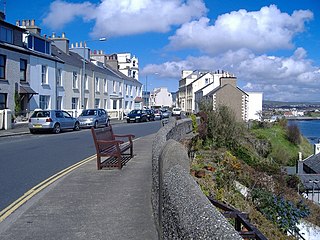
Port St Mary is a village district in the south-west of the Isle of Man. The village takes its name from the former Chapel of St Mary which is thought to have overlooked Chapel Bay in the village. Its population is 1,953 according to the 2011 census. In the 19th century it was sometimes called Port-le-Murray.

Black Bourton is a village and civil parish about 2 miles (3 km) south of Carterton, Oxfordshire. The village is on Black Bourton Brook, a tributary of the River Thames. The 2011 Census recorded the parish population as 266. RAF Brize Norton adjoins the parish. The northern boundary of the parish is along the middle of the main runway of the airfield.
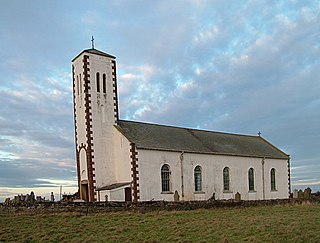
Jurby is one of the seventeen parishes of the Isle of Man. It is located in the north-west of the island in the sheading of Michael.

Andreas is one of the seventeen parishes of the Isle of Man. It is located in the north of the island in the sheading of Ayre. The main settlement in the parish in the village of Andreas, which is also known as Kirk Andreas.

No. 452 Squadron is a Royal Australian Air Force (RAAF) air traffic control unit. It was established in 1941 as a fighter squadron, in accordance with Article XV of the Empire Air Training Scheme during World War II. The squadron flew Supermarine Spitfires for the entire war, initially over the United Kingdom and Nazi-occupied Europe. It was later based in Australia and the Netherlands East Indies, before being disbanded in 1945. It was re-raised in its current role in February 2011.
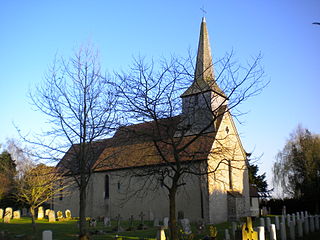
Tangmere is a village, civil parish, and electoral ward in the Chichester District of West Sussex, England. Located three miles (5 km) north east of Chichester, it is twinned with Hermanville-sur-Mer in Lower Normandy, France.

No. 457 Squadron was a Royal Australian Air Force (RAAF) fighter squadron of World War II. Equipped with Supermarine Spitfire fighters, it was formed in England during June 1941 under Article XV of the Empire Air Training Scheme. The squadron was transferred to Australia in June 1942 and saw combat in the South West Pacific Area before being disbanded in November 1945.
Royal Air Force Andreas or more simply RAF Andreas is a former Royal Air Force station in the Isle of Man which was operational between 1941 and 1946. It was built in fields between Andreas and Bride in the north of the island. As was common practice, the station was named after the parish in which it was situated.
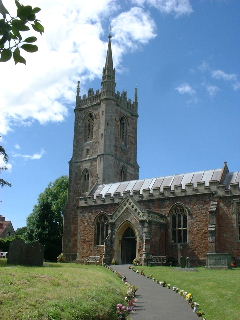
The Anglican St Andrew's Church is on the outskirts of Chew Stoke, within the English county of Somerset. The church, parts of which date from the 15th century, is a Grade II* listed building.

Andreas or Kirk Andreas is a village on the Isle of Man, lying in the north of the island, 5 km from the island's second town, Ramsey. There is a large, and nowadays little used, airfield in the vicinity.

St Matthew's Church is in the village of Stretton, Cheshire, England. The church is recorded in the National Heritage List for England as a designated Grade II listed building. It is an active Anglican parish church in the diocese of Chester, the archdeaconry of Chester and the deanery of Great Budworth. Its benefice is combined with that of St Cross, Appleton Thorn.

St Mary the Virgin, Acocks Green is a Grade II listed Church of England parish church in Acocks Green, Birmingham, England.

St Martin's Church is a redundant Anglican church in the village of Preston Gubbals, Shropshire, England. It is recorded in the National Heritage List for England as a designated Grade II* listed building, and is under the care of the Churches Conservation Trust.

The Church of St Mary the Virgin, Deane, is an Anglican parish church in Deane, Bolton, Greater Manchester, England. It is a member of Deane deanery in the archdeaconry of Bolton, diocese of Manchester. It is a Grade II* listed building.
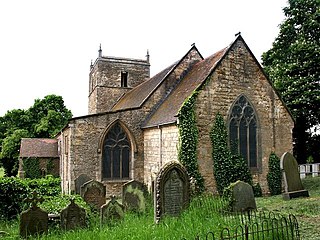
St Chad's Church, Harpswell, is a parish church in the Church of England in Harpswell, Lincolnshire.

St Andrew's Church is an Anglican parish church in the centre of Farnham, Surrey. It is a Grade I listed building and surviving parts of the structure date back to the Middle Ages. It is in the Archdeaconry of Surrey, in the Diocese of Guildford. The churchyard contains the grave of the political activist William Cobbett, and there is a memorial to the hymn-writer Augustus Toplady.

St Patrick's Church is a parish church of the Church of England in Jurby parish, near the northwest coast of the Isle of Man. Scotland and Ireland can be seen across the Irish Sea on a moderately clear day. The church also has views down the west coast to Peel, across the northern plain of the island, and to the central hills.

The Church of St Michael and All Angels is a Church of England parish church in Great Torrington, Devon. It has been a Grade II* listed building since 1951.

The Church of St Andrew, Netherton is an Anglican parish church situated in Netherton in the Metropolitan Borough of Dudley. The building was designed by Thomas Lee and it opened in 1830. In 1844 it became the parish church for Netherton.

The Church of St Anne is a parish church in the village of Catterick, North Yorkshire, England. The present church structure dates back to the early 15th century, but some of its stones are from an earlier structure located on the same site. A place of worship in Catterick village is believed to have been in existence since the 7th century. The church has been dedicated to Saint Anne since its original consecration date of 1415.

























